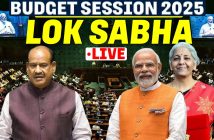By Arun Kejriwal
The just-concluded calendar year 2022 was tough on many fronts. The Russia-Ukraine war, rising inflation that led to interest rates rising sharply, volatile crude prices, and so on. And all of this happened coming out of over two years of massive disruption on the back of Covid.
In such a scenario, it was just not possible to expect global markets to perform. They too were under pressure. Dow Jones lost 3,425.86 points or 9.43 per cent to close at 32,912.44 points. NASDAQ was indeed very weak and lost 5,178.52 points or 33.10 per cent to close at 10,466.48 points. Looking at what happened in the US, India is clearly an outperformer.
BSE SENSEX gained for the seventh year in a row and was up 2,587.22 points or 4.44 per cent for the year at 60,840.74 points. NIFTY gained 751.25 points or 4.33 per cent to close at 18,105.30 points. BANK NIFTY was a very important sector in the domestic markets and gained handsomely. It was up 7,504.75 points or 21.15 per cent to close at 42,986.45 points. It could be said that the BFSI space was the saviour for the Indian markets.
People around the world are talking in hushed tones that the US could be heading for some sort of recession. In market or financial parlance, recession is a cuss word and no one likes to talk or discuss the subject. A strong economy like the US and recession round the corner? Seems absurd but that could happen in the latter half of the calendar year 2023.
The US FED has raised interest rates sharply during the current year. The rise on four consecutive occasions was of 75 basis points each besides three more hikes of 100 basis points total. The current rate band in the US is 4.25-4.5 per cent.
This is the highest rate in a very long time and has gone up from a band of 0-0.25 per cent a year ago. This is not all and the FED is talking of more to happen in the current year. More importantly, this would keep the rates at elevated levels for a substantially long time.
With the average American hit hard by inflation, rising interest rates and fuel pump rates which are at elevated levels, the citizen is just unable to manage his monthly expenses. While currently the job rate and economic data suggests that things have not turned out the worse, the lurking fear of the cuss-word, recession is hurting. When will the FED stop raising rates and then will reduction happen or continue at higher levels.
The US imports almost everything of daily use whether it be textiles, consumer goods or what have you. They survive on exports of technology, defence equipment and higher end of products. They have their own supply of crude and play the global markets depending on international prices. The current relations with China being what they are, they do have to look for alternative destinations.
Let us now compare the situation in India. Our economy is comparatively more self-resilient. The two large components of import for us are crude oil and edible oil. While efforts to reduce the same are on-going it would be a long-drawn affair for the time being.
To offset the financial burden, exports of various products are being undertaken to improve the balance of payments situation. Incentives under the PLI (production linked incentive) scheme have been extended to many industries and sectors, and one is seeing the benefits of the same.
There would be some drop in GDP when the inevitable recession hits the country. In such a scenario, profits of companies would take a hit as well. US markets could see an outflow of investor flows and the direction could be to countries where there is money making potential or expectation. Would India be a beneficiary of such a situation? Let us analyse the same in some detail.
Currently our benchmark indices with the BSE SENSEX at 60,000 and NIFTY at 18,000 are richly valued. The PE multiple of the BSE SENSEX on a trailing basis is 23.71 while it is 22.99 based on projected basis. (Source: BSE). Similarly NIFTY 50 has a PE of 21.65. On the price to book basis, BSE SENSEX trades at 3.53 times P/B while NIFTY trades at 4.22 P/B. On comparison basis, the Dow Jones PE is 21.23.
There is expectation that results for the quarter October-December 2022 and January-March 2023 would see a sharp growth in profits and revenue for the benchmark stocks. Whether that does happen or not is debatable. We have seen how FPIs sold in the first eight-nine months of calendar year 2022 and reduced their exposure. The fact that their bets in other countries, by shifting money out of India, did not pay off, is a different matter.
Our markets bounced back quite sharply and made new lifetime highs as recently as December 2022.
India held steady because of huge inflows to domestic institutions through SIPs and direct subscription. Our domestic funds were able to weather the storm of FPI selling.
The moving of savings to the capital markets was certainly welcome and in any case it was high time that the same happened. It would be reasonable to expect that going forward this would continue. The only variable could be the pace at which it happens.
Looking at the above. It would be fair to conclude that while a recession or recession-like scenario in the latter half of the calendar year 2023 is a possibility in the United States, the same or similar scenario in India is far off.
(Arun Kejriwal is the founder of Kejriwal Research and Investment Services. The views expressed are personal)
–IANS
arun/sha




